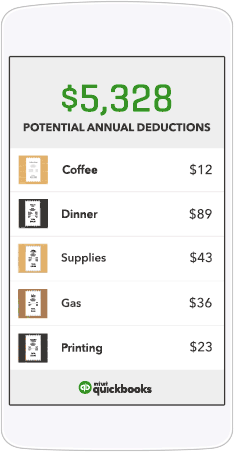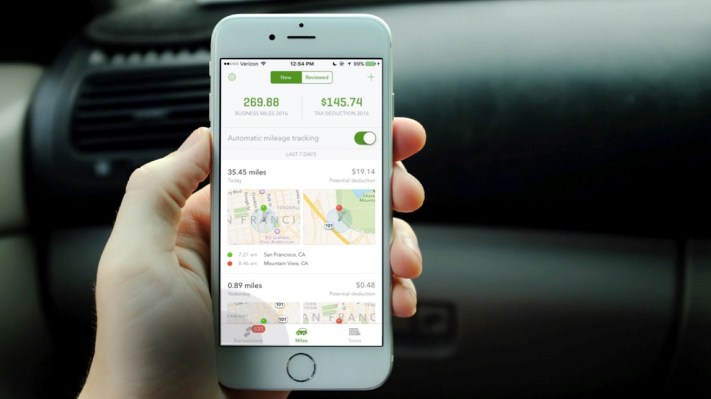Intuit, the company behind Mint, QuickBooks and TurboTax, traditionally focused on serving individuals and small businesses. But over the course of the last few years, it noticed that there is a large and growing group of freelancers, whose tax situation is often complicated and who have to meticulously track all of their expenses. With QuickBooks Self-Employed, it now offers a product that streamlines expense management and invoicing, both of which then make tax season a lot easier — and it’s turning to machine learning to power this.
As Intuit senior Vice President and Chief Product Officer of Small Business, Alex Chriss, told me, about three years ago, the company noted that some of its Mint customers were using all kinds of hacks to track their expenses in Mint by, for example, categorizing their business expenses as “other” so they could separate their personal expenses from their business expenses. “So we took a step back and said: we don’t have a product for these folks,” Chriss said. “We looked at the trends in the market and the self-employed market is growing incredibly fast.”
![]() It took the team only about 90 days from deciding to build an app specifically for the self-employed market to launching it on iOS and Android. It was able to do this relatively fast because it was able to leverage many of the existing building blocks of Mint and QuickBooks.
It took the team only about 90 days from deciding to build an app specifically for the self-employed market to launching it on iOS and Android. It was able to do this relatively fast because it was able to leverage many of the existing building blocks of Mint and QuickBooks.
Instead of having to focus on those, the team was able to work on the user interface instead. Chriss likened the experience to Tinder. As you look at your bank account, you simply swipe left if it’s a business expense.
And that’s where Intuit is now starting to leverage its new machine learning capabilities. “We always had a lot of data running through our systems,” said Chriss. “Now we are thinking about we can use this to help the individual customer.”
Few other companies, after all, sit on the trove of personal finance data that Intuit has access to thanks to Mint and TurboTax — and starting today, it’s going to use this technology to, in Chriss’ words, make using the application “easier than doing nothing” (which would likely result in searching through shoeboxes of receipts once tax season comes around and missing out on potential deductions).
 For this product, this means using the existing data to train a model that can accurately decide whether that coffee you had at Starbucks is a personal pick-me-up or a business expense during a meeting with a customer. Currently, this system is about 90 percent accurate (and you obviously get the option to make changes if necessary).
For this product, this means using the existing data to train a model that can accurately decide whether that coffee you had at Starbucks is a personal pick-me-up or a business expense during a meeting with a customer. Currently, this system is about 90 percent accurate (and you obviously get the option to make changes if necessary).
Completely new in the app is also support for capturing receipts and using an OCR scan to import that data without every having to edit any text (at least in the ideal world). This feature is now live in the app and while it’s able to match receipt scans with credit card transactions for extra accuracy, it can also pull the data in directly from the receipt. This new feature is now available in the U.S., U.K., Australia and Canada.
The app also makes it easy to track the miles you drive in your own car for work. Given that it’s easy enough to use a phone to track where you go, QuickBooks Self-Employed can now simply log your drives and then lets you categorize them as personal or for business. Intuit argues that its users find 45 percent more potential deductions than paper logs. While this feature doesn’t really use machine learning just yet, it’s probably not much of a stretch to see how Intuit could use its knowledge about other expenses to predict whether a trip was for business or not.
“I think we’ll get to a point where we make it so you don’t have to enter any information,” Chriss believes. “The next big leap is to prompt you and ask you questions. Are you on a train? Did you have a meal? Did you know you can deduct that?”
QuickBooks Self-Employed is, of course, tightly integrated with TurboTax (and it features both a plan with this integration for $17/month and one without for $10 a month — and both are 50 percent off right now). This allows freelancers to estimate their taxes throughout the year, for example, so they know how much to set aside each quarter to prepare April 15th.
“For the self-employed, we know that their time is their most valuable resource,” said Chriss. “If they are spending their time not thinking about growing their business, it’s time spend away from being away from earning income. Our goal is to make that time go to zero.”
